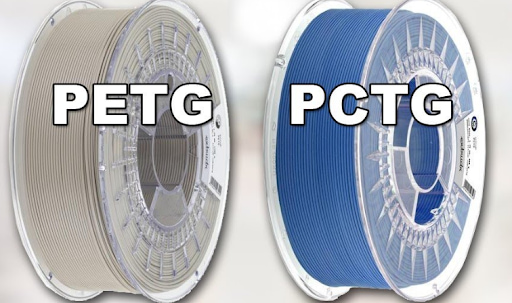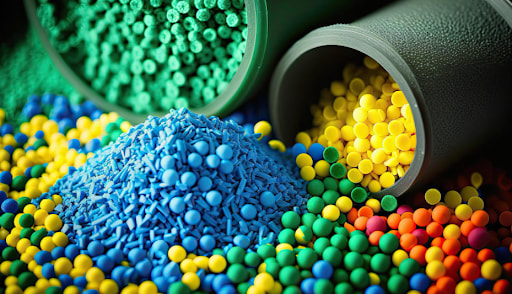PCTG vs. PETG Plastic: What Are The Differences?
PCTG vs PETG are considered the top most popular plastic materials today. The choice between PCTG vs PETG needs to be carefully chosen to optimize their properties for each different application. The following article will analyze in detail the outstanding properties, common applications and great benefits of PCTG vs PETG. Let's update useful information about these two great materials!
1. What Are PETG & PCTG Plastics?

PCTG vs PETG are considered the top most popular plastic materials today
PCTG vs PETG are two lines of materials that are widely used in many industries today.PETG plastic has the full name of Polyethylene Terephthalate Glycol. This is a thermoplastic polymer created by modifying PET with additional glycol. The modification process helps PETG increase its durability many times compared to PET. In general, PETG has some basic features such as impact resistance, safety for human health, transparency and easy shaping when heated. PETG plastic is widely used in our daily life applications. Some industries that apply PETG include food packaging, medical equipment and 3D printing.
Read more: What is Polyethylene terephthalate (PET)?
PCTG plastic has the full name of Polycyclohexylenedimethylene Terephthalate Glycol. This is a line of copolyester materials similar to PETG but contains cyclohexane dimethanol (CHDM) in its chemical structure. The addition of CHDM gives them a significant improvement in their excellent properties. Basically, PCTGs possess good hardness, flexibility, impact resistance and transparency. They are commonly used in packaging, medical applications and consumer products that require both transparency and high strength.
2. PCTG vs. PETG: Comparing Properties
PCTG vs PETG are both ideal choices for many industries in life and technology. In addition, PCTG vs PETG both possess their own outstanding properties that contribute to the unique suitability of PCTG vs PETG for different applications. Comparing the properties of PETG vs PCTG will help your choice be many times more optimal:

PCTG vs PETG both possess their own outstanding properties
2.1. Impact resistance
This is one of the properties that is always of great interest when talking about PCTG vs PETG . It can be seen that in terms of impact resistance, PCTG has an advantage over PETG.
For PCTG, they are supplemented with cyclohexane dimethanol (CHDM), so the hardness is somewhat superior to PETG. As for PETG, they possess high durability but the ability to resist strong and even extremely strong impacts is slightly less than PCTG.
2.2. Transparency
Transparency is considered an excellent property when talking about PCTG vs PETG. However, many reviews have shown that PCTG often has a slightly higher optical transparency.
This is evidenced by the fact that PCTG appears in many applications that require exposure and transparency such as cosmetic packaging, food packaging, medicine bottles and some medical devices that require visibility inside.
2.3. Flexibility
PCTG vs PETG both provide good flexibility for applications. In particular, PCTG is somewhat more flexible than PETG due to the addition of CHDM to its chemical structure.
Thanks to its flexibility, PCTG is more suitable for applications that require bending or mechanical stress resistance. In addition, although PETG is quite flexible, they are harder and more prone to cracking when exposed to high stress environments.
2.4. Chemical resistance
PCTG vs PETG both work well in chemical environments. However, in terms of chemical resistance, PETG is slightly more resistant to certain solvents and chemicals than PCTG.
Because of its ability to perform well in harsh chemical environments, PETG is always a great choice for many applications that require environmental abrasion resistance.
2.5. Easy to thermoform
PCTG vs PETG are both thermoformed. In general, PETG is generally easier to process and thermoform than PCTG.
Of these, PETG is often used in 3D printing and manufacturing processes due to its lower processing temperatures and less complex forming requirements. As for PCTG, they are harder, so they may require higher temperatures and more specialized equipment, so the processing process will be a bit more complicated.
3. PCTG vs. PETG: Pros & Cons

When comparing PCTG vs PETG, PETG is more affordable than PCTG
| PCTG vs PETG |
Pros |
Cons |
| PCTG |
Superior impact resistance: PCTG is ideal for applications that require high durability, such as medical devices, safety equipment and consumer goods.
Improved flexibility: PCTG is flexible and can withstand mechanical stress and bending without cracking. This flexibility is beneficial for products that require resilience and longevity.
High transparency: PCTG is ideal for packaging designs especially in cosmetics or medical products.
Good chemical resistance: PCTG is ideal for packaging applications in industries such as health care and personal care such as lotions, detergents or disinfectants.
Health safety: PCTG is safe for medical applications such as surgical instruments or food and pharmaceutical packaging.
|
Higher Cost: This makes it less cost effective for large scale or budget sensitive projects.
Lower Heat Resistance: When comparing PCTG vs PETG, PCTG has lower heat resistance making it less suitable for high temperature applications or environments. |
| PETG |
Cost-effective: When comparing PCTG vs PETG, PETG is more affordable than PCTG. This makes it a popular choice for projects that require a balance between cost and performance.
Easy to process: When comparing PCTG vs PETG, PETG is easier to thermoform and process. They have a lower melting point and require less specialized equipment than PCTG.
Great for 3D printing: They are widely used in 3D printing. This is due to their ease of use, strong layer adhesion, and good balance between flexibility and strength.
Chemical resistance: PETG is suitable for packaging in environments that are exposed to hazardous substances. They are resistant to a wide range of chemicals and abrasive solvents.
Food safe: PETG is approved for food contact. This makes them ideal for packaging and storing food. |
Prone to Scratching: When comparing PCTG vs PETG, PETG is more prone to surface scratches. This can affect its appearance and transparency over time.
Limited Heat Resistance: PETG has moderate heat resistance. This means that it can warp or lose its structural integrity at high temperatures. |
4. PCTG vs. PETG: Comparing Applications
PCTG vs PETG have their own distinct properties. This also helps to classify them for different applications. Let’s compare the common applications of these two great materials.
4.1. Applications of PCTG

The packaging made from them all has a high-end and luxurious transparent finish for the product
Medical devices: When comparing PCTG vs PETG, it can be seen that PCTG is preferred in medical devices due to its superior impact resistance and biocompatibility. Some of the common applications include surgical instruments, drug delivery systems, and diagnostic tools.
Cosmetic packaging: PCTG is an ideal choice for cosmetic packaging. The packaging made from them all has a high-end and luxurious transparent finish for the product.
Household products: Some of the common applications of PCTG include reusable bottles, food preparation tools, food containers, and other kitchen utensils. They provide the product with high flexibility and durability, making it suitable for heavy use over a long period of time.
Sports equipment: Due to their flexibility and durability, PCTG is used in protective sports equipment and accessories. They help users own products that are resistant to impacts such as helmets, gloves, handles and some other protective gear.
Electronic device housings: Electronic devices made from PCTG are often impact resistant and highly transparent. They help protect internal components from physical damage.
4.2. Applications of PETG

Some popular products of PETG include bottles, jars, containers, and zip bags
3D Printed decorations: PETG is widely used in 3D printing because of its excellent layer adhesion. It is suitable for printing products from basic to complex.
Food and beverage packaging: Some popular products include bottles, jars, containers, and zip bags. These packages give the appearance of the product excellent transparency. In addition, they are also safe for human health.
Medical instruments: Some types of medical trays, blister packs, and other sterile packaging are often produced with this material. They give the product the ability to be sterilized without affecting the material contained inside.
Consumer products: Products made from PETG that we can easily encounter are protective boxes, toys, and household items. Consumer products made from this material always show good durability, flexibility, chemical resistance, and are safe for human health.
5. Conclusion
In conclusion, PCTG vs PETG are both ideal materials in human production life. Although they have many similarities in properties, they also have their own unique characteristics for different applications. Many industries have applied PCTG vs PETG in production such as food packaging, medical equipment and consumer goods. Understanding the properties and characteristics of PCTG vs PETG will help you make a better choice for your upcoming project!
6. About EuroPlas
EuroPlas is proud to be one of the most reputable and trustworthy material suppliers worldwide. You can easily find and buy bio-filler, color masterbatch, plastic additives, engineering plastic compounds, and bioplastic compounds, etc., with just a click of the mouse. Besides, come to EuroPlas' blog today to update more useful materials information. We are a provider of optimal material solutions with a series of high quality plastic lines. Our solutions meet the diverse needs of the world's industries, not only in terms of high standards and reliability but also in terms of environmental obligations.